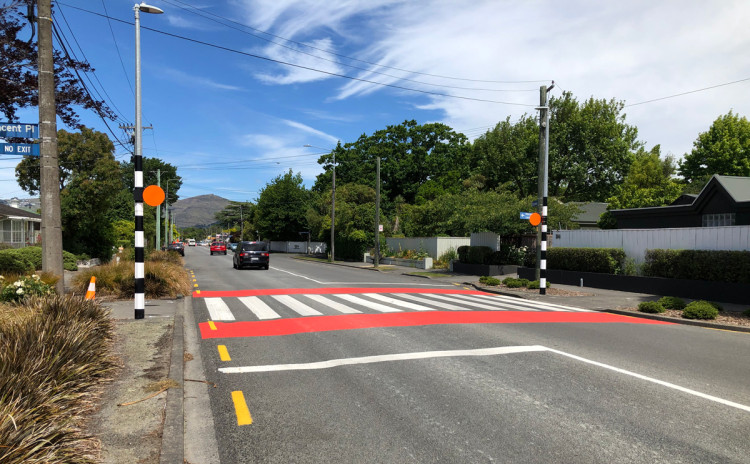Coloured surfacing may be used as a permanent treatment in our streets. It can help to direct or warn road users in permanent treatments, or to visually enhance streets and public places.
Note that any coloured markings within the roadway or directing traffic needs to comply with the Traffic Control Devices (TCD) Rule. For more detailed guidance on coloured surfacing in these situations refer to the Coloured surfacing principles best practice guidance note, where you can find information on the legislative context, application for different purposes, colour specifications and material types, and installation and maintenance.
PNG: Coloured surfacing principles best practice guidance note
Examples relevant for pedestrians include:

Coloured surfacing highlights zebra crossing, Christchurch. (Photo: Ann-Marie Head)
Coloured surfacing can be used in new or existing pedestrian environments to provide for placemaking opportunities and visually enhance streets. It is important to ensure all safety aspects are considered including colours, patterns and textures that can affect people’s sensory and cognitive abilities.
Coloured surfacing is also a tool in adaptive urbanism, where public space is reclaimed (eg a street, or a car park) to provide safer space for people to walk, ride their cycles or just to be there and linger; and to improve its aesthetic appeal. This type of semi-permanent infrastructure should be implemented in lower-risk streets with low volumes of traffic and low speeds or where walking (and other active modes) are being encouraged. Coloured surfacing used within newly delineated space where traffic does not enter does not have to comply with the TCD Rule, but must not include any device covered by the TCD Rule.
For more detailed guidance on the use of coloured surfacing in semi-permanent installations and to visually enhance streets refer to the Handbook for Tactical Urbanism in Aotearoa and the Draft Roadway Art Guidance.
Handbook for Tactical Urbanism in Aotearoa [PDF, 20 MB]
Roadway Art Guidance [PDF, 9.4 MB]

Temporary street changes including roadway art, Hetana Street, Matamata. (Photo: Waka Kotahi)
In both scenarios (semi-permanent and permanent), the following factors are important to consider when choosing to use coloured surfacing: